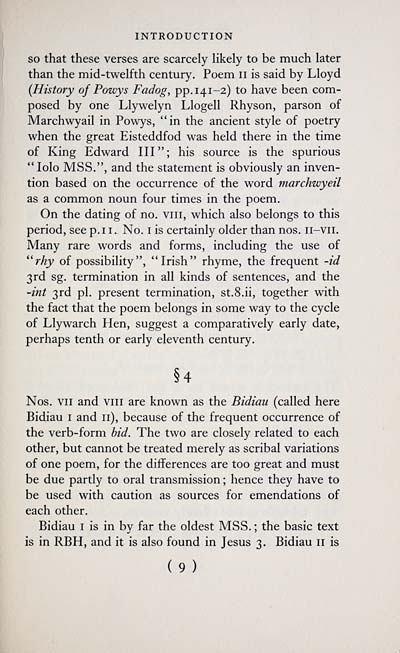Download files
Complete book:
Individual page:
Thumbnail gallery: Grid view | List view

INTRODUCTION
SO that these verses are scarcely Hkely to be much later
than the mid-twelfth century. Poem ii is said by Lloyd
{History of Powys Fadog, pp.141-2) to have been com-
posed by one Llywelyn Llogell Rhyson, parson of
Marchwyail in Powys, "in the ancient style of poetry
when the great Eisteddfod was held there in the time
of King Edward III"; his source is the spurious
" lolo MSS.", and the statement is obviously an inven-
tion based on the occurrence of the word marchwyeil
as a common noun four times in the poem.
On the dating of no. viii, which also belongs to this
period, see p.ii. No. i is certainly older than nos. ii-vii.
Many rare words and forms, including the use of
'VAj of possibility", "Irish" rhyme, the frequent -id
3rd sg. termination in all kinds of sentences, and the
-int 3rd pi. present termination, st.S.ii, together with
the fact that the poem belongs in some way to the cycle
of Llywarch Hen, suggest a comparatively early date,
perhaps tenth or early eleventh century.
§4
Nos. VII and viii are known as the Bidiau (called here
Bidiau I and 11), because of the frequent occurrence of
the verb-form bid. The two are closely related to each
other, but cannot be treated merely as scribal variations
of one poem, for the differences are too great and must
be due partly to oral transmission ; hence they have to
be used with caution as sources for emendations of
each other.
Bidiau I is in by far the oldest MSS. ; the basic text
is in RBH, and it is also found in Jesus 3. Bidiau 11 is
(9)
SO that these verses are scarcely Hkely to be much later
than the mid-twelfth century. Poem ii is said by Lloyd
{History of Powys Fadog, pp.141-2) to have been com-
posed by one Llywelyn Llogell Rhyson, parson of
Marchwyail in Powys, "in the ancient style of poetry
when the great Eisteddfod was held there in the time
of King Edward III"; his source is the spurious
" lolo MSS.", and the statement is obviously an inven-
tion based on the occurrence of the word marchwyeil
as a common noun four times in the poem.
On the dating of no. viii, which also belongs to this
period, see p.ii. No. i is certainly older than nos. ii-vii.
Many rare words and forms, including the use of
'VAj of possibility", "Irish" rhyme, the frequent -id
3rd sg. termination in all kinds of sentences, and the
-int 3rd pi. present termination, st.S.ii, together with
the fact that the poem belongs in some way to the cycle
of Llywarch Hen, suggest a comparatively early date,
perhaps tenth or early eleventh century.
§4
Nos. VII and viii are known as the Bidiau (called here
Bidiau I and 11), because of the frequent occurrence of
the verb-form bid. The two are closely related to each
other, but cannot be treated merely as scribal variations
of one poem, for the differences are too great and must
be due partly to oral transmission ; hence they have to
be used with caution as sources for emendations of
each other.
Bidiau I is in by far the oldest MSS. ; the basic text
is in RBH, and it is also found in Jesus 3. Bidiau 11 is
(9)
Set display mode to: Large image | Transcription
Images and transcriptions on this page, including medium image downloads, may be used under the Creative Commons Attribution 4.0 International Licence unless otherwise stated. ![]()
| Early Gaelic Book Collections > Matheson Collection > Early Welsh gnomic poems > (25) |
|---|
| Permanent URL | https://digital.nls.uk/76486607 |
|---|
| Description | Items from a collection of 170 volumes relating to Gaelic matters. Mainly philological works in the Celtic and some non-Celtic languages. Some books extensively annotated by Angus Matheson, the first Professor of Celtic at Glasgow University. |
|---|
| Description | Selected items from five 'Special and Named Printed Collections'. Includes books in Gaelic and other Celtic languages, works about the Gaels, their languages, literature, culture and history. |
|---|

